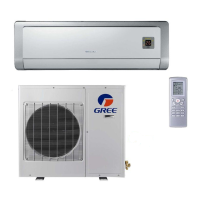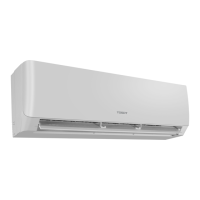2. Low voltage overcurrent protection
Possi ble reason: Sudden drop of supply voltage.
3. Communic ation malfun ction
Processin g method: Check if communic ation signal cable is c onnected reliably.
4. Senso r open or shor t circuit
Processin g meth od: Check whether s ensor is normal, c onnected with the corre sponding po sition on th e
controller and if damage of lead wire is found.
5. Compressor over load protection
Possi ble rea sons: insufficient or too much refrigrant; blockage of capillary an d increas e of suct ion temp.;
improp er running of compressor, burning in or stuck of bea ring, damage of discharge valve;
malfunc tion of pro tector.
Processi ng method: adjust refrige rant amount; replace the capillary; replace the compressor; use
univers al meter to check if the cont acto r of compress or is fine wh en it is not overh eated , if not replace
the prote ctor.
6. System malfun ction
i.e.overloadprotection.Whentubetemperature(Check thetemperatureof outdoor heat exchanger
when cooling and check the temperatur e of indoor heat exchanger when heating) is too high,
protectionwill beactivated.
Possi ble reasons: Outdoor tempera ture is too high when cooling; insufficient outdoor air circulation;
refrigerant flow malfunction.
please refer to the malfunction analysis in the previous section for handling method .
7. IPM module protection
Processing method:Once the module malfunction happens,if it persists for a long time and can not be self- canceled,
cut off the power and turn off the unit,and then re-energize the unit again after about 10 min.After repeating the
procedure for sever times, if the malfunction still exists,replace the module.
Analysis or processing of some of the malfunction display:
1. Compressor discharge protection
Possible reasons: shortage of refrigerant; blockage of air filter; poor ventilation or air flow short pass for condenser;
the system has noncondensing gas (such as air, water etc.); blockage of capillary assy (including filter); leakage
inside four-way valve causes incorrect operation; malfunction of compressor; malfunction of protection relay;
malfunction of discharge sensor; outdoor temperature too high.
Processing method: refer to the malfunction analysis in the above section.
Troubleshooting
49

